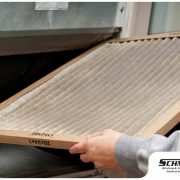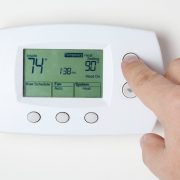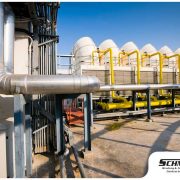How to Heat and Cool a Warehouse Efficiently
The vast spaces typical of warehouses can make temperature regulation a formidable task—too much heat can compromise employees’ productivity and the integrity of stored goods, while excessive cold poses its own set of problems. In this post from HVAC repair experts at Schmitt, you’ll learn the factors that let you heat and cool a warehouse effectively.

Efficient Ventilation and Insulation
Efficient heating and cooling starts with proper ventilation and insulation. Insulating doors, windows and other openings is crucial to contain heat during cooler times and keep interiors cool on warmer days. High-grade seals and double-pane windows can significantly improve insulation, while vinyl strips or air curtains at doorways minimize energy loss. Additionally, enhancing natural ventilation can help reduce reliance on HVAC systems.
Strategic Temperature Control
Temperature regulation in a warehouse should prioritize areas occupied by people. Zoning or sectioning off these areas allows for focused temperature control and improves energy efficiency. In larger warehouses where zoning is less feasible, organization systems that minimize traffic and bring employees together in specific areas can enhance efficiency. High-efficiency HVAC systems ensure that heating and cooling efforts are not wasted on unoccupied spaces.
Advanced Technologies for Improved Efficiency
Installing smart HVAC technology with the help of heating repair experts is a game-changer for most warehouses. Smart sensors and programmable thermostats can optimize heating and cooling based on real-time occupancy and weather significantly reduce energy costs. Additionally, technologies like energy recovery ventilators (ERVs) recycles heat within the warehouse.
Addressing Air Stratification
Air stratification, where warm air rises and cool air settles at the bottom, can lead to inefficient heating and cooling. Installing high-volume, low-speed (HVLS) fans can help mitigate this issue by ensuring continuous air circulation. This is particularly effective in fluctuating climates where temperature shifts can affect warehouse conditions.
Cool Roof Systems and Solar Energy
Cool roof systems and solar energy can yield long-term energy savings. Cool roofs reflect sunlight and heat away from the building and reduce cooling costs during warmer months. Similarly, solar walls or solar panels use the sun’s energy to generate energy, which can greatly offset heating costs and reduce the warehouse’s carbon footprint.
Regular HVAC Maintenance
Routine maintenance of HVAC systems cannot be overstated. Regular checks and cleaning ensure that your heating and cooling systems operate efficiently and at peak performance. With regular maintenance, you choose your system’s downtime and won’t get caught off-guard when it breaks down.
Need help with warehouse heating and cooling? Allow our team of AC repair experts in San Francisco, CA, for all your needs. Call Schmitt today at (415) 689-7849 or fill out this contact form to reach us.















Leave a Reply
Want to join the discussion?Feel free to contribute!